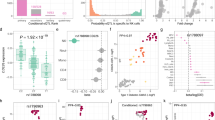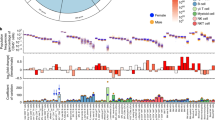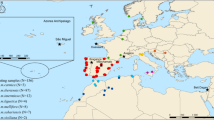Abstract
The natural killer gene complex (NKC) on chromosome 6 contains clusters of genes that encode both activation and inhibitory receptors expressed on mouse natural killer (NK) cells. NKC genes, particularly belonging to the Nkrp1 and Ly49 gene families, display haplotype differences between different mouse strains and allelic polymorphisms of individual genes, as previously revealed by conventional analysis in a small number of inbred mouse strains. Herein we used array-based comparative genomic hybridization (aCGH) to efficiently compare the NKC in 21 mouse strains to the reference C57BL/6 strain. By using unsupervised clustering methods, we could sort these variations into the same groups as determined by previous RFLP analyses of Nkrp1 and Ly49 genes. Prospective analyses of aCGH and RFLP data validated these relationships. Moreover, aCGH data predicted monoclonal antibody reactivity with an allospecific determinant on molecules expressed by NK cells. Taken together, these data demonstrate the structural variation in the NKC between mouse strains as well as the usefulness of aCGH in analysis of complex, polymorphic gene clusters.
This is a preview of subscription content, access via your institution
Access options
Subscribe to this journal
Receive 6 digital issues and online access to articles
$119.00 per year
only $19.83 per issue
Buy this article
- Purchase on Springer Link
- Instant access to full article PDF
Prices may be subject to local taxes which are calculated during checkout






Similar content being viewed by others
References
Yokoyama WM . Chapter 16. Natural killer cells. In: Paul WE (ed.) Fundamental Immunology, 6th edn. Lippincott-Raven: New York, 2008, pp 483–517.
Yokoyama WM, Ryan JC, Hunter JJ, Smith HR, Stark M, Seaman WE . cDNA cloning of mouse NKR-P1 and genetic linkage with Ly-49. Identification of a natural killer cell gene complex on mouse chromosome 6. J Immunol 1991; 147: 3229–3236.
Kelley J, Walter L, Trowsdale J . Comparative genomics of natural killer cell receptor gene clusters. PLoS Genet 2005; 1: 129–139.
Iizuka K, Naidenko OV, Plougastel BF, Fremont DH, Yokoyama WM . Genetically linked C-type lectin-related ligands for the NKRP1 family of natural killer cell receptors. Nat Immunol 2003; 4: 801–807.
Carlyle JR, Jamieson AM, Gasser S, Clingan CS, Arase H, Raulet DH . Missing self-recognition of Ocil/Clr-b by inhibitory NKR-P1 natural killer cell receptors. Proc Natl Acad Sci USA 2004; 101: 3527–3532.
Carlyle JR, Mesci A, Fine JH, Chen P, Belanger S, Tai LH et al. Evolution of the Ly49 and Nkrp1 recognition systems. Semin Immunol 2008; 20: 321–330.
Karlhofer FM, Ribaudo RK, Yokoyama WM . MHC class I alloantigen specificity of Ly-49+ IL-2-activated natural killer cells. Nature 1992; 358: 66–70.
Yokoyama WM, Plougastel BF . Immune functions encoded by the natural killer gene complex. Nat Rev Immunol 2003; 3: 304–316.
Kung SK, Su RC, Shannon J, Miller RG . The NKR-P1B gene product is an inhibitory receptor on SJL/J NK cells. J Immunol 1999; 162: 5876–5887.
Carlyle JR, Martin A, Mehra A, Attisano L, Tsui FW, Zuniga-Pflucker JC . Mouse NKR-P1B, a novel NK1.1 antigen with inhibitory function. J Immunol 1999; 162: 5917–5923.
Carlyle JR, Mesci A, Ljutic B, Belanger S, Tai LH, Rousselle E et al. Molecular and genetic basis for strain-dependent NK1.1 alloreactivity of mouse NK cells. J Immunol 2006; 176: 7511–7524.
Yokoyama WM, Kehn PJ, Cohen DI, Shevach EM . Chromosomal location of the Ly-49 (A1, YE1/48) multigene family. Genetic association with the NK 1.1 antigen. J Immunol 1990; 145: 2353–2358.
Wilhelm BT, Gagnier L, Mager DL . Sequence analysis of the ly49 cluster in C57BL/6 mice: a rapidly evolving multigene family in the immune system. Genomics 2002; 80: 646–661.
Makrigiannis AP, Patel D, Goulet ML, Dewar K, Anderson SK . Direct sequence comparison of two divergent class I MHC natural killer cell receptor haplotypes. Genes Immun 2005; 6: 71–83.
Proteau MF, Rousselle E, Makrigiannis AP . Mapping of the BALB/c Ly49 cluster defines a minimal natural killer cell receptor gene repertoire. Genomics 2004; 84: 669–677.
Belanger S, Tai LH, Anderson SK, Makrigiannis AP . Ly49 cluster sequence analysis in a mouse model of diabetes: an expanded repertoire of activating receptors in the NOD genome. Genes Immun 2008; 9: 509–521.
Graubert TA, Cahan P, Edwin D, Selzer RR, Richmond TA, Eis PS et al. A high-resolution map of segmental DNA copy number variation in the mouse genome. PLoS Genet 2007; 3: e3.
Freeman JL, Perry GH, Feuk L, Redon R, McCarroll SA, Altshuler DM et al. Copy number variation: new insights in genome diversity. Genome Res 2006; 16: 949–961.
Pinkel D, Albertson DG . Comparative genomic hybridization. Annu Rev Genomics Hum Genet 2005; 6: 331–354.
Grus WE, Zhang J . Rapid turnover and species-specificity of vomeronasal pheromone receptor genes in mice and rats. Gene 2004; 340: 303–312.
Brekke KM, Garrard WT . Assembly and analysis of the mouse immunoglobulin kappa gene sequence. Immunogenetics 2004; 56: 490–505.
Bachmanov AA, Beauchamp GK . Taste receptor genes. Annual Review of Nutrition 2007; 27: 389–414.
Beck JA, Lloyd S, Hafezparast M, Lennon-Pierce M, Eppig JT, Festing MF et al. Genealogies of mouse inbred strains. Nat Genet 2000; 24: 23–25.
Hogan B, Beddington R, Costantini F, Lacy E . Manipulating the mouse embryo. Cold Spring Harbor Laboratory Press: Plainview, New York, 1994, 487pp.
Willison KR, Lyon MF . A UK-centric history of studies on the mouse t-complex. Int J Dev Biol 2000; 44: 57–63.
Ryan JC, Turck J, Niemi EC, Yokoyama WM, Seaman WE . Molecular cloning of the NK1.1 antigen, a member of the NKR-P1 family of natural killer cell activation molecules. J Immunol 1992; 149: 1631–1635.
Koo GC, Peppard JR . Establishment of monoclonal anti-Nk-1.1 antibody. Hybridoma 1984; 3: 301–303.
Petkov PM, Ding Y, Cassell MA, Zhang W, Wagner G, Sargent EE et al. An efficient SNP system for mouse genome scanning and elucidating strain relationships. Genome Res 2004; 14: 1806–1811.
Frazer KA, Eskin E, Kang HM, Bogue MA, Hinds DA, Beilharz EJ et al. A sequence-based variation map of 8.27 million SNPs in inbred mouse strains. Nature 2007; 448: 1050–1053.
Wade CM, Kulbokas III EJ, Kirby AW, Zody MC, Mullikin JC, Lander ES et al. The mosaic structure of variation in the laboratory mouse genome. Nature 2002; 420: 574–578.
Boursot P, Belkhir K . Mouse SNPs for evolutionary biology: beware of ascertainment biases. Genome Res 2006; 16: 1191–1192.
Depatie C, Muise E, Lepage P, Gros P, Vidal SM . High-resolution linkage map in the proximity of the host resistance locus CMV1. Genomics 1997; 39: 154–163.
Forbes CA, Brown MG, Cho R, Shellam GR, Yokoyama WM, Scalzo AA . The Cmv1 host resistance locus is closely linked to the Ly49 multigene family within the natural killer cell gene complex on mouse chromosome 6. Genomics 1997; 41: 406–413.
Mehta IK, Smith HRC, Wang J, Margulies DH, Yokoyama WM . A ‘chimeric’ C57L-derived Ly49 inhibitory receptor resembling the Ly49D activation receptor. Cell Immunol 2001; 209: 29–41.
Anderson SK, Dewar K, Goulet ML, Leveque G, Makrigiannis AP . Complete elucidation of a minimal class I MHC natural killer cell receptor haplotype. Genes Immun 2005; 6: 481–492.
Cahan P, Li Y, Izumi M, Graubert TA . The impact of copy number variation on local gene expression in mouse hematopoietic stem and progenitor cells. Nat Genet 2009; 41: 430–437.
Selzer RR, Richmond TA, Pofahl NJ, Green RD, Eis PS, Nair P et al. Analysis of chromosome breakpoints in neuroblastoma at sub-kilobase resolution using fine-tiling oligonucleotide array CGH. Genes Chromosomes Cancer 2005; 44: 305–319.
Gentleman RC, Carey VJ, Bates DM, Bolstad B, Dettling M, Dudoit S et al. Bioconductor: open software development for computational biology and bioinformatics. Genome Biol 2004; 5: R80.
Hetland M . Extending Python Beginning Python: From Novice to Professional. Apress: Berkeley, 2005, pp 357–372.
Verzani J . Using R for introductory statistics. Chapman and Hall/CRC Press: Boca Raton, 2005, 432pp.
Pevsner J (ed). Gene expression: Microarray data analysis. In: Bioinformatics and functional genomics. John Wiley & Sons, Inc.: Hoboken, New Jersey, 2003, pp 189–221.
Yokoyama WM, Jacobs LB, Kanagawa O, Shevach EM, Cohen DI . A murine T lymphocyte antigen belongs to a supergene family of type II integral membrane proteins. J Immunol 1989; 143: 1379–1386.
Acknowledgements
The authors thank Megan Cooper and Beatrice Plougastel for careful reading of the manuscript. Funding. Work in the Yokoyama laboratory is supported by grants from the National Institute of Allergy and Infectious Diseases and the Howard Hughes Medical Institute. The Graubert laboratory is supported by the National Cancer Institute (P01 CA101937).
Author information
Authors and Affiliations
Corresponding author
Ethics declarations
Competing interests
The authors declare no conflict of interest.
Additional information
Supplementary Information accompanies the paper on Genes and Immunity website
Supplementary information
Rights and permissions
About this article
Cite this article
Higuchi, D., Cahan, P., Gao, J. et al. Structural variation of the mouse natural killer gene complex. Genes Immun 11, 637–648 (2010). https://doi.org/10.1038/gene.2010.48
Received:
Revised:
Accepted:
Published:
Issue Date:
DOI: https://doi.org/10.1038/gene.2010.48
Keywords
This article is cited by
-
The evolution of the natural killer complex; a comparison between mammals using new high-quality genome assemblies and targeted annotation
Immunogenetics (2017)
-
Analysis of the mouse 129-strain Nkrp1-Clr gene cluster reveals conservation of genomic organization and functional receptor–ligand interactions despite significant allelic polymorphism
Immunogenetics (2011)



